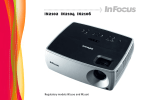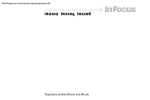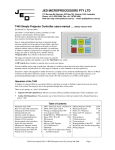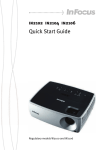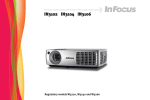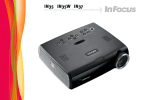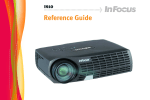Download AB Soft IN2106 Projector User Manual
Transcript
Declaration of Conformity FCC Warning Manufacturer: InFocus Corporation, 27500 SW Parkway Ave. Wilsonville, Oregon 97070 USA European Office: Louis Armstrongweg 110, 1311 RL Almere, The Netherlands We declare under our sole responsibility that this projector conform to the following directives and norms: Note: This equipment has been tested and found to comply with the limits for a Class B digital device, pursuant to part 15 of the FCC Rules. These limits are designed to provide reasonable protection against harmful interference in a residential installation. This equipment generates, uses and can radiate radio frequency energy and, if not installed and used in accordance with the instructions, may cause harmful interference to radio communications. However, there is no guarantee that interference will not occur in a particular installation. If this equipment does cause harmful interference to radio or television reception, which can be determined by turning the equipment off and on, the user is encouraged to try to correct the interference by one or more of the following measures: --Reorient or relocate the receiving antenna. --Increase the separation between the equipment and receiver. --Connect the equipment into an outlet on a circuit different from that to which the receiver is connected. --Consult the dealer or an experienced radio/TV technician for help. EMC Directive 2004/108/EC EMC: EN 55022 EN 55024 EN 61000-3-2 EN 61000-3-3 Low Voltage Directive 2006/95/EC Safety: IEC 60950-1: 1st Edition Trademarks Changes or modifications not expressly approved by InFocus Corporation may void authority to operate the equipment. Apple, Macintosh, and PowerBook are trademarks or registered trademarks of Apple Computer, Inc. IBM is a trademark or registered trademark of International Business Machines, Inc. Microsoft, PowerPoint, and Windows are trademarks or registered trademarks of Microsoft Corporation. Adobe and Acrobat are trademarks or registered trademarks of Adobe Systems Incorporated. DLP® and the DLP logo are registered trademarks of Texas Instruments and BrilliantColor™ is a trademark of Texas Instruments. InFocus, In Focus, and INFOCUS (stylized) are either registered trademarks or trademarks of InFocus Corporation in the United States and other countries. Canada This Class B digital apparatus complies with Canadian ICES-003. Cet appareil numérique de la classe B est conforme à la norme NMB-003 du Canada. Agency Approvals UL, cUL Other specific Country Approvals may apply. Please see product certification label. This document applies to regulatory models W2100 and W2106. Input ratings: 100-240Vac, 3.0A, 50-60Hz InFocus reserves the right to alter product offerings and specifications at any time without notice. 1 • • Locate the projector in a well-ventilated area without any obstructions to intake or exhaust vents. Do not place the projector on a tablecloth or other soft covering that may block the vents. • Locate the projector at least 4' (1.2 m) away from any heating or cooling vents. • Use only InFocus-approved ceiling mounts. Warning: To prevent eye injury if the projector is ceiling mounted, wear protective eyewear before opening lamp door. A warning sticker is included with the user documentation. Place this sticker on the lamp door if the projector is mounted on the ceiling. • Only genuine InFocus lamps are tested for use in this projector. InFocus is not liable for the performance, safety or certification of any other lamps. The use of other lamps violates the projector warranty and voids all certification marks on this projector. • Use only the power cord provided. A surge-protected power strip is recommended. • Refer to this guide for proper startup and shutdown procedures. • Hg – Lamp contains mercury. Manage in accordance with local disposal laws. See www.lamprecycle.org. • In the unlikely event of a lamp rupture, particles may exit through the projector side vents. When the projector is turned on, keep people, food, and drinks out of the "keep out" area under and around the projector, as indicated by the "X" areas below. m m 3’ / 1 m 8’ / 2 .4 m / 5’ /0 .6 3’ / 1 2’ Table of Contents Introduction 3 Positioning the projector 5 Projector and device connector guide 6 Connecting a computer source 9 Required computer connections 9 Optional computer connections 9 Displaying an image 10 Adjusting the image 11 Connecting a video device 12 Composite video connection 13 S-video connection 13 VESA connection 13 Component video connection 13 Shutting down the projector 14 Troubleshooting your setup 14 Using the remote control 22 Using the audio 23 Using the keypad buttons 24 Optimizing computer images 25 Presentation features 25 Optimizing video images 26 Customizing the projector 26 Using the menus 27 Basic Picture menu 28 Advanced Picture menu 29 Setup menu 30 Status and Service menu 32 Maintenance 33 Cleaning the lens 33 Using the security lock 33 Replacing the projection lamp 34 Important Operating Considerations for Safety m 1.5 Follow these instructions to help ensure image quality and lamp life over the life of the projector. Failure to follow these instructions may affect the warranty. For complete details of the warranty, see the Warranty booklet. Place the projector in a horizontal position no greater than 15 degrees off axis. 2 Introduction Your new digital projector is simple to connect, easy to use, and straightforward to maintain. It is a versatile projector that is flexible enough for business presentations and home video viewing too. The IN2102 has native SVGA 800x600 resolution, the IN2104 has native XGA 1024x768 resolution, and the IN2106 has WXGA 1280x800 resolution. This guide applies to all products. They are compatible with a wide variety of computers and video devices. keypad Product specifications To read the latest specifications on your multimedia projector, be sure to visit our website at www.infocus.com, as specifications are subject to change. Accessories zoom (rear ring) The standard accessories that came with your projector are listed in the included Quick Start card. Optional accessories can be found on our website at www.infocus.com or at your retailer or dealer. focus (front ring) remote control receiver (IR) elevator foot release Online Registration Register your projector on our website at www.infocus.com/register to activate your warranty and receive product updates, announcements, and registration incentives. connector panel 3 Connector Panel The projector provides both computer and video connection options, including: • VESA computer (2) • S-video • Composite video • Separate audio inputs for video and computer audio in S-video audio USB out computer monitor out 5 volt output RS-232 The projector also provides the following connectors: • Monitor out, to provide an image on your desktop computer as well as on the projection screen • Audio out, to provide sound for external speakers • USB, to provide mouse control (used with an optional remote control only) • A 5 volt DC output (see below) security lock It also has an RS-232 connector for serial control. The Command Line Interface (CLI) specifications and commands are on our website. 5 volt DC output The 3.5mm mini-jack triggers provide a 5 volt, 2 amp DC output. It provides a constant output while the projector is on. It is designed to provide power for an InFocus LiteShow II wireless device, which allows wireless projection. More information can be found on our website at www.infocus.com or at your retailer or dealer. 4 adjustable foot composite video Positioning the projector Table 1: Range of distance to the screen for a given screen size To determine where to position the projector, consider the size and shape of your screen, the location of your power outlets, and the distance between the projector and the rest of your equipment. Here are some general guidelines: Distance to screen • Position the projector on a flat surface at a right angle to the screen. The projector must be at least 4.9 feet (1.5m) from the projection screen. Diagonal Screen Size (inches/m) Maximum distance (feet/m) Minimum Distance (feet/m) • Position the projector within 10 feet (3m) of your power source and within 6 feet (1.8m) of your video device (unless you purchase extension cables). To ensure adequate cable access, do not place the projector within 6 inches (.15m) of a wall or other object. 60/1.5 80/2 92/2.3 150/3.8 7.7/2.3 10.3/3.1 11.8/3.6 19.4/5.9 8.5/2.6 11.5/3.5 13.1/4.0 21.7/6.6 • If you are installing the projector on the ceiling, refer to the installation guide that comes with the Ceiling Mount Kit for more information. To turn the image upside down, see “Ceiling” on page 31. We recommend using an InFocus authorized ceiling mount. • Position the projector the desired distance from the screen. The distance from the lens of the projector to the screen, the zoom setting, and the video format determine the size of the projected image. • The image exits the projector at a given angle. This image offset is 115%. This means that if you have an image 10’ high, the bottom of the image will be 1.15’ above the center of the lens. 10 ft high image Projection angle bottom of image 1.15 ft above center of lens 5 lens center Projector and device connector guide The following illustration and table should help you find the connectors to use and obtain the best resolution possible from your input devices, such as computers, standard VCRs, DVD players (progressive and interlaced), HDTV sources (1080i and 720p HDTV formats), TV and satellite tuners, camcorders, video games (progressive and interlaced), and laser disc players. audio out computer S-video audio in monitor out USB 5 volt output RS-232 security lock composite video 6 adjustable foot Video Device Standard Broadcast TV (not HDTV) via: cable, digital cable, satellite TV, DVD, or VCR Standard Video Camera Video Compatibility If Your Device Connector Is Attach to Adapter or Labeled Connector on Projector For Setup Instructions, see Comments NTSC, PAL, and SECAM formats Composite video or S-video Video 2 or Video 1 Composite video connection on page 13. Not for progressive (i.e. HDTV) sources. See page 8. S-video connection on page 13 NTSC, PAL, and SECAM formats Composite video or S-video Video 2 or Video 1 Composite video connection on page 13. Not for progressive (i.e. HDTV) sources. See page 8. S-video connection on page 13 NTSC, PAL, and SECAM formats Composite video or S-video Video 2 or Video 1 Standard Video Game Composite video connection on page 13. S-video connection on page 13 7 Not for progressive (i.e. HDTV) sources. See page 8. Video Device HDTV (High Definition TV) Progressive DVD Attach to Adapter or Labeled Connector on Projector Video Compatibility If Your Device Connector Is 1080i, 720p VGA Computer 1 or Computer 2 Component 480i Component video Computer 1 or Computer 2 via optional VESA to Component adapter 1080i, 720p VGA Computer 1 or Computer 2 Component 480p and 480i Component video Computer 1 or Computer 2 via optional VESA to Component adapter 1080i, 720p VGA Computer 1 or Computer 2 Component 480p and 480i Component video Computer 1 or Computer 2 via optional VESA to Component adapter Progressive Video Game 8 For Setup Instructions, see VESA connection on page 13 Component video connection on page 13 VESA connection on page 13 Component video connection on page 13 VESA connection on page 13 Component video connection on page 13 Comments Connecting a computer source connect computer cable Required computer connections Connect one end of the provided computer cable to the Computer 1 or Computer 2 connector on the projector and the other to the VESA connector on your computer. If you are using a desktop computer, you will need to disconnect the monitor cable from the computer’s video port first (you can connect this monitor cable to the Monitor Out connector on the projector, see below). connect power cord Connect the black power cord to the Power connector on the side of the projector and to your electrical outlet. The Power light on the Status Indicator Panel (page 14) turns amber. connect audio cable NOTE: Always use the power cord that shipped with the projector. Optional computer connections To get sound from the projector, connect an audio cable (optional cable, not included) to your computer and to the Audio In Computer connector on the projector. You may also need an adapter. connect monitor cable If you are using a desktop computer and want to see the image on your computer screen as well as on the projection screen, connect the computer’s monitor cable to the Monitor Out connector on the projector. NOTE: The projector must be plugged for this feature to work. connect USB cable To advance slides in a PowerPoint presentation using an optional remote control, plug the USB cable into the USB mouse connector on your computer and the USB connector on the projector. 9 Displaying an image Press the Power button. press Power button The Power light on the Status Indicator Panel (page 14) blinks green and the fans start to run. When the lamp comes on, the start up screen displays and the Power light is steady green. It can take a minute for the image to achieve full brightness. ? No start up screen? Get help on page 14. turn on computer or video device Turn on your computer or video device. The image should appear on the projection screen. If it doesn’t, press the Source button on the projector’s keypad or remote. If using a laptop, make sure it’s external video port is active. Many laptops do not automatically turn on their external video port when a projector is connected. Usually a key combination like FN + F8 or CRT/LCD key turns the external display on and off. Locate a function key labeled CRT/LCD or a function key with a monitor symbol. Press FN and the labeled function key simultaneously. Refer to your laptop’s documentation to learn your laptop’s key combination. activate laptop’s external port monitor key or LCD/CRT key FN key ? No laptop image? Try pressing the Auto Image button on the keypad. Get help on page 15. 10 Adjusting the image adjust height If necessary, adjust the height of the projector by pressing the elevator foot release button to extend the foot. release button If necessary, rotate the leveling foot located at the rear of the projector. elevator foot Avoid placing your hands near the hot exhaust vent at the side of the projector. adjust distance Position the projector the desired distance from the screen at a 90 degree angle to the screen. See page 5 for a table listing screen sizes and distances. adjust zoom or focus Adjust the zoom or focus. focus (front ring) If the image is not square, first make sure that the projector is perpendicular to the screen. If the image is larger or smaller on the top or bottom edge of the screen, press the top Keystone button to reduce the upper part of the image, and press the bottom Keystone button to reduce the lower part. adjust keystone If the left or right side of the screen is larger or smaller the other, you can turn the projector to the left or to the right a few degrees to square the image. Adjust the Contrast or Brightness in the Basic Picture menu. See page 28 for help with these menu adjustments. adjust Basic Picture menu For Aspect Ratio, keep in mind that DVD players must be configured for 16:9 in order to view the highest quality image. For more information regarding Aspect Ratio, see page 12. 11 zoom (rear ring) Connecting a video device 4:3 screen You can connect video devices such as VCRs, DVD players, camcorders, digital cameras, video game consoles, HDTV receivers, and TV tuners to the projector. You can connect the audio directly to the projector to get sound from the built-in speaker, or you can bypass the projector’s audio system and connect the audio directly from your source to a stereo or home theater system. 16:9 screen Do Not Use 4:3 mode You can connect the projector to most video devices that can output video. You cannot directly connect the coaxial cable that enters your house from a cable or satellite company, the signal must pass through a tuner first. Examples of tuners are digital cable boxes, VCRs, digital video recorders, and satellite TV boxes. Basically, any device that can change channels is considered a tuner. Before connecting your projector, you should decide which aspect ratio you want to use. The projector’s Aspect Ratio setting is accessed through the Resize button on the remote or through the projector’s Basic Picture Menu. See page 28 for more information. 16:9 mode What is Aspect Ratio? Aspect ratio is the ratio of the image width to image height. TV screens are usually 4:3, which is the default for this projector. HDTV and most DVDs are 16:9. If you’re projecting onto a screen, the size/shape of the screen may determine which aspect ratio to use. If you are projecting onto a blank wall, you don’t have the screen size restriction. What you plan to project will also help you choose between 4:3 and 16:9. Most TV shows are 4:3, while most movies are 16:9. Native mode (NTSC only) If you have a 16:9 screen then you should select an aspect ratio of 16:9 for anamorphic movies or HDTV, and Native for 4:3 content. If you have a 4:3 screen you should still use 16:9 for anamorphic movies or HDTV, but you also have the option of using either 4:3 (to fill the screen) or Native (for direct pixel mapping) for 4:3 content. Keep in mind that anamorphic movies only appear correctly if the DVD player is set to output to a 16:9 television. 12 Video device connections Component video connection No video cables are provided with the projector. You can order cables from InFocus or provide your own. If your HD video device has component connectors, an optional Component to VESA adapter can be used. Plug the component cable into the video device. Plug the other end of the component cable into the adapter and plug the adapter into the Computer 1 or Computer 2 connector. Component offers the highest quality video output. Composite video connection Plug the composite video cable’s yellow connector into the video-out connector on the video device. Plug the other yellow connector into the yellow Video 2 connector on the projector. Plug the white connector of a Mini-plug audio Y-cable into the left audio out connector on the video device and plug the red connector into the right audio out connector on the video device. Plug the other end of the cable into the Audio In Video connector on the projector. Keep in mind that video output from composite connections is not as high quality as S-video. S-video connection If your video device uses a round, four-prong S-video connector, plug an S-video cable into the S-video connector on your video device and into the Video 1 connector on the projector. Use the audio cable as described above. Keep in mind that S-video delivers higher quality video output than composite. VESA connection If your video device has a 15-pin VGA output, plug one end of the included computer cable into the VGA connector on your video source. This connector may be labeled “To Monitor” on the video source. Plug the computer cable into the Computer 1 or Computer 2 connector on the projector. 13 The Status Indicator Panel on top of the projector indicates the state of the projector and can help you troubleshoot. Shutting down the projector The projector automatically displays a black screen after no active source is detected for 30 minutes. This black screen helps preserve the life of the projector. The image returns when an active source is detected or a remote or keypad button is pressed. Screen Save Time Table 2: Status indicator light behavior and meaning You can make the black screen appear after a preset number of minutes by turning on the Screen Save Time feature in the Setup menu. See page 30. Auto Off Time The projector also has a Auto Off Time feature that automatically turns the lamp off after no active sources are detected and no user interaction with the projector is performed for 30 minutes. By default, this feature is off. You can change the length of time, see page 30. Status Indicator Panel icons Meaning Power, solid amber The projector is plugged in. Power, blinking green The power button has been pressed and the software is initializing. The projector is on and initialized. Power, solid green Turning off the projector To turn the projector off, press the Power button on the remote or keypad. The lamp turns off and the LED blinks amber for 1 minute while the fans continue to run to cool the lamp. When the lamp has cooled, the LED lights amber and the fans stop. Unplug the power cable to completely power off the projector. Power, blinking amber The power button has been pressed to turn the projector off and the fans are running to cool the projector. Thermometer The projector is too hot. Make sure the vents aren’t blocked (see page 20). Turn off the projector and wait one minute, then turn the projector on again. Contact Technical Support if the problem persists. Lamp Turn off the projector and wait one minute, then turn the projector on again. If the lamp light turns on again, replace the lamp and reset the lamp timer. Wrench/Service Turn off the projector and wait one minute, then turn the projector on again. If the service lamp turns on again, service is required. Visit www.infocus.com/service to contact Service. Troubleshooting your setup If your image appears correctly on the screen, skip to the next section. If it does not, troubleshoot the setup. 14 Problem Solution Result no start up screen plug power cord into the projector press power button correct image Startup Screen only start up screen appears press the Source button activate laptop’s external port computer image projected Startup Screen A A A restart laptop 15 no computer image, just the words “Signal out of range” Signa l rang out of e press the Auto Image button on keypad computer image projected adjust computer refresh rate in Control Panel>Display>Settings>Advanced>Adapter (location varies by operating system) A A A you may also need to set a different resolution on your computer, as shown in the following problem, “image fuzzy or cropped” Only my laptop’s background appears, not the Desktop icons Disable “Extend my Windows Desktop” in Control Panel>Display>Settings>Display 2 (location varies by operating system) Background and Desktop projected A A A A Uncheck this option, then click Apply 16 Problem Solution Result image fuzzy or cropped set your computer’s display resolution to the native resolution of the projector (Start>Settings>Control Panel>Display>Settings tab) image clear and not cropped A A A For a laptop, disable laptop monitor or turn-on dualdisplay mode move projector, adjust zoom, adjust height image not centered on screen correct image adjust horizontal or vertical position in Advanced Picture menu 17 Problem Solution Result image not square adjust Keystone on keypad square image image not sharp correct image adjust Sharpness in the Basic Picture menu AB AB image does not fit 4:3 or 16:9 screen change aspect ratio to 4:3 or 16:9 in Basic Picture>Aspect ratio menu 18 correct image Problem Solution Result image upside down turn off Ceiling Mount in Setup menu correct image AB AB image reversed left to right turn off Rear Project in Setup menu correct image A projected colors don’t match source AB adjust color, tint, brightness, contrast in the Basic Picture menu COLOR correct image COLOR 19 Problem Solution Result The video embedded in my PowerPoint presentation does not play on the screen turn off the internal LCD display on your laptop Embedded video plays correctly A B A A B lamp won’t turn on, Temperature light is on make sure vents aren’t blocked, turn off the projector and allow it to cool for one minute lamp turns on Startup Screen Temperature light 20 Problem Solution Result “Replace lamp” message appears at startup, lamp won’t turn on, Lamp light is turned on lamp must be replaced (see page 34) lamp turns on lamp door Startup Screen Lamp light replace lamp Still need assistance? If you need assistance, visit our website at www.infocus.com/service or call us. Check out our HOW TO section there for additional information on using this projector for home theater or gaming applications. See the Quick Start card for support contact information. This product is backed by a limited warranty. An extended warranty plan may be purchased from your dealer. When sending the projector in for repair, we recommend shipping the unit in its original packing material, or having a professional packaging company pack the unit. Please insure your shipment for its full value. 21 • Using the remote control The remote uses two (2) provided AA batteries. They are easily installed by removing the cover from the remote’s back, aligning the + and - ends of the batteries, sliding them into place, and then replacing the cover. Caution: When replacing the batteries, be aware that using batteries other than the type provided with the projector may risk severe damage to the remote. When disposing of the batteries, be sure to do so in an environmentally proper manner. navigation buttons To operate, point the remote at the front of the projector (not at the computer). The range of optimum operation is about 15 feet (4.5m). Press the remote’s Power button to turn the projector on and off (see page 14 for shutdown info). Press the remote’s Menu button to open the projector’s menu system. Use the arrow buttons to navigate, and the Select button to select features and adjust values in the menus. See page 27 for more info on the menus. The remote also has a Source button to switch between sources. The remote also has: • Volume buttons to adjust the sound. • Custom button that can be assigned to a special function, like Blank Screen or Freeze (see page 30). • Source button to switch between sources. • Blank button to blank the screen. • Presets button to select stored settings (see page 28). • Mute button to silence the audio. • Auto Image button to resynch the projector to the source • Resize button to switch among aspect ratios (see page 28). Troubleshooting the remote • Make sure you’re pointing the remote at the projector or the screen, not the computer, and are within the remote range of 15 feet (4.5m). For best results, point the remote at the projector. Make sure the batteries are installed in the proper orientation and are not dead. 22 Using the audio connect audio cable Using the projector’s speaker To use the projector’s speaker, connect your source to the Audio In Computer or Video connectors. To adjust the volume, press the Volume buttons on the keypad or remote. Troubleshooting Audio If you aren’t hearing the audio, check the following: • Make sure the audio cable is connected to the correct Audio In connector, Computer or Video. • Make sure the volume is turned up enough. Press the Volume button on the keypad or remote. • Make sure the correct source is active. • Make sure that you are connected to an “audio out” connector on the source as opposed to a “line-in” or “microphone” connector. • Adjust the audio source. • If playing a video, make sure the playback has not been paused. adjust volume Connecting external speakers The projector can be attached to external amplified speakers by connecting a 3.5mm stereo audio cable from the Audio Out connector on the projector to the amplified speakers. Alternatively, you can bypass the projector’s audio system and connect the audio directly from your source to a stereo or home theater system. external speakers with own power source audio out speaker cable 23 Using the keypad buttons Most buttons are described in detail in other sections, but here is an overview of their functions: Power–turns the projector on and off (page 10). Auto Image–resets the projector to the source. Presets–cycles through the available preset settings (page 28). Keystone–adjusts squareness of the image (page 11). Menu–opens the on-screen menus (page 27). menu navigation buttons Select–confirms choices made in the menus (page 27). Up/Down arrows–navigates to and adjusts settings in the menus (page 27). Volume–adjusts sound (page 23). Source–changes the active source. 24 Optimizing computer images Presentation features After your computer is connected properly and the computer’s image is on the screen, you can optimize the image using the onscreen menus. For general information on using the menus, see page 27. Several features are provided to make giving presentations easier. Here is an overview, details are found in the menu section. • The Custom key allows you to assign various features to the button. The default effect is Source Info, which displays information about the projector and current source. See page 30 for details. Change the Aspect Ratio. Choose the option that best fits your input source (page 28). • The Startup Screen option lets you change the default start up screen to a blank or default screen (page 31). • Adjust the Color Temperature in the Advanced Picture menu (page 28). • • Adjust the Phase, Tracking, or Horizontal or Vertical position in the Advanced Picture menu (page 29). Two options, Auto Off and Screen Save Time, are provided to automatically shut down the projector after several minutes of inactivity or display a black screen. This helps preserve lamp life (page 30). • Once you have optimized the image for a particular source, you can save the settings using Presets. This allows you to quickly recall these settings later (page 28). • Adjust the Keystone, Contrast, or Brightness in the Basic Picture menu (page 28). • 25 Optimizing video images Customizing the projector After your video device is connected properly and the image is on the screen, you can optimize the image using the onscreen menus. For general information on using the menus, see page 27. You can customize the projector for your specific setup and needs. See page 30 to page 31 for details on these features. • For rear projection, turn Rear Project on in the Setup menu. • Adjust the Keystone, Contrast, Brightness, Color, or Tint in the Basic Picture menu (page 28). • For ceiling mounted projection, turn Ceiling Mount on in the Setup menu. • Change the Aspect Ratio. Choose the option that best fits your input source (page 28). • Specify which source the projector checks first for active video during power-up. • Select a Sharpness setting (page 28). • Specify the function of the Custom key on the remote. • Adjust the Color Temperature. Select a listed warmth value (page 29). • Turn the projector’s display messages on and off. • Turn on Overscan to remove noise on the edges of the image. • Turn on power saving features. • Specify blank screen colors and start up logos. • Specify the language viewed on the menus. • Save settings for the active source as a preset. 26 Using the menus keypad navigation buttons To open the menus, press the Menu button on the keypad or remote. (The menus automatically close after 60 seconds if no buttons are pressed.) Use the arrow buttons to move up and down to highlight the desired menu, then press the Select button. To change a menu setting, highlight it, press Select, then use the up and down arrow buttons to adjust the value or select an option or turn the feature on or off. Press Select to confirm your changes. Use the arrows to navigate to another setting. When your adjustments are complete, press Menu to access a different menu; press the Menu button at any time to navigate to the higher-level menu and ultimately close the menus. The menus are grouped by usage: • The Basic Picture menu provides common image adjustments. • The Advanced Picture menu provides more complex image adjustments. • The Setup menu provides set-up type adjustments that are not changed often. • The Status and Service menu provides information about the projector and source. Basic Picture menu Setup menu 27 Advanced Picture menu Status and Service menu Basic Picture menu To adjust the following settings, highlight the setting, press Select, use the up and down arrows to adjust the values, then press Select to confirm the changes. Brightness: changes the intensity of the image. Contrast: controls the degree of difference between the lightest and darkest parts of the picture and changes the amount of black and white in the image. Basic Picture menu Sharpness: (video sources only) changes the clarity of the edges of a video image. Select a sharpness setting. Color: adjusts a video image from black and white to fully saturated color. The color setting applies to video sources only. Basic Picture Tint: adjusts the red-green color balance in the image of NTSC video images. The tint setting applies to NTSC video sources only. Aspect Ratio: Aspect ratio is the ratio of the image width to image height. TV screens are usually 4:3. HDTV and most DVDs are 16:9. The default is 4:3. Contrast 50 Auto Sharpness 50 Native Color 50 4:3 Tint 50 16:9 Aspect Ratio Apply Preset… Auto Letterbox Panorama Select Auto to have the projector choose the ratio. Choose Native to see the unmodified input with no resizing by the projector. Select 16:9 to watch enhanced widescreen DVDs. Aspect ratio For more information regarding Aspect Ratio, see page 12. Apply Preset...: Presets are provided that optimize the projector for displaying computer presentations and video images under certain conditions. There are also user-definable presets. To set a preset, adjust the image, select Save User in the Presets menu. You can recall these settings in the future by selecting the User preset. Keystone: adjusts the image vertically and makes a squarer image. You can also adjust keystone from the keypad. increasing keystone 28 decreasing keystone Advanced Picture menu BrilliantColor™: produces an expanded on-screen color spectrum that delivers enhanced color saturation for bright, true-to-life images. Choose Normal Look for most video sources and Bright Look for most computer sources. White Peaking: (video sources only) increases the brightness of whites that are near 100%. Color Temperature: changes the intensity of the colors. Select a listed relative warmth value. Overscan: removes noise around the video image. Advanced Picture menu Phase: adjusts the horizontal phase of a computer source. Sync Threshold: (progressive signals only) If a hardware device, such as a DVD player, is not syncing properly with the projector, select this option to help it to sync when connected to the projector. Tracking: adjusts the vertical scan of a computer source. Color Space: This option applies to computer and component video sources. It allows you to select a color space that has been specifically tuned for the input signal. When Auto is selected, the projector automatically determines the standard. To choose a different setting, turn off Auto, then choose RGB for computer sources, choose either REC709 or REC601 for component video sources. Gamma: select the appropriate gamma from among Video, Film, Bright, and CRT. Horizontal/Vertical Position: adjusts the position of a computer source. 29 Power Sounds: Controls whether the projector makes a sound when powered on and off. Setup menu Language: allows you to select a language for the onscreen display. Auto Source: When this feature is On, the projector automatically finds the active source, checking the selected Power-up Source first. When this feature is Off, the projector defaults to the source selected in Power-up Source. To display another source, you must manually select one by pressing the Source button on the remote or keypad. Custom Key: allows you to assign a different function to the Custom button, allowing you to quickly and easily use the effect. Highlight an effect and press Select to choose a different one. • Blank Screen: displays an empty screen. • Mute: turns off all sound. • Aspect Ratio: toggles among 4:3, 16:9, and Native (see page 12 and page 28). • Source: cycles through available sources. • Auto Image: resets the projector to the source (page 24). • Freeze Screen: pauses the projected image. • Source Info: the default effect. It opens a window with projector and source information. • Projector Info: opens a window with projector information. • Overscan: removes noise around the image. • Closed Captions: cycles through caption options. Setup menu Power-up Source: determines which source the projector checks first for active video during power-up. AC Power On: When this feature is on, the projector automatically turns on when electrical power is connected. This allows control of ceiling mounted projectors with a wall power switch. Video Standard: when it is set to Auto, the projector attempts to automatically pick the video standard based on the input signal it receives. (The video standard options may vary depending on your region of the world.) If the projector is unable to detect the correct standard, the colors may not look right or the image may appear “torn.” If this happens, manually select a video standard by selecting NTSC, PAL, or SECAM from the Video Standard menu. Auto Off Time: automatically turns the projector off after no signals are detected for a preset number of minutes. If an active signal is received before the projector powers down, the image will be displayed. Screen Save Time: automatically blanks the screen with a black color after no signals are detected for a preset number of minutes. The image returns when an active source is detected or a remote or keypad button is pressed. Closed Captions: (S-video and composite NTSC sources only) turns closed captions on and off (if your source includes closed captions). By default, when you mute the projector, captions are displayed. You can control which captions (if any) should appear when muted or not muted by turning mute on or off, then choosing this menu and selecting CC1 (closed caption 1, the most common channel), CC2, or Off. Lamp Low Power: toggles between on and off. Turn it on to lower the light output of the lamp. This also lowers the fan speed, making the projector quieter. 30 Ceiling Mount: turns the image upside down for ceiling-mounted projection. PIN Protect: The PIN (personal identification number) feature allows you to password protect your projector. Once you enable the PIN feature, you must enter the PIN before you can project an image. The default PIN on this projector is Menu-Arrow Up-Arrow Down-Select-Source. Use the navigation buttons on the remote or keypad to enter the correct 5-button press sequence. When all 5 numbers are entered correctly, press the Select button on the remote or keypad to select OK. If the message “Wrong PIN” appears, verify the code and re-enter it. If you mis-enter a number, you must enter 5 numbers and press the Select button in order to access the “Wrong PIN” message and re-enter the code. Rear Project: reverses the image so you can project from behind a translucent screen. Prevent PC Screen Saver: prevents your computer from going into Screen Save mode. The projector must be connected to the PC via a USB cable for this feature to work. Startup Screen: allows you to display a blank screen instead of the default screen at startup, and when no source is detected. To enter the PIN at projector startup: Take Snapshot...: captures the current image and allows it to be used as the startup screen image. Power up the projector. The “Enter PIN” dialog box appears after the startup screen. Enter the PIN. Use the navigation buttons on the remote or keypad to enter the correct button press sequence. See the description above for instructions. Blank Screen Color: determines what color is displayed when you press the Blank button on the remote. To change the PIN: Blank Screen Style: Select Solid, Timer, or Test Patterns. The Timer option is useful for classroom tests or break times during meetings. Select “Change PIN...” in the Setup menu. Enter the existing PIN. Enter the new PIN. You can navigate between OK and Cancel by pressing the up and down buttons on the keypad. Select OK or Cancel by pressing the Select button. Verify the new PIN. Show Messages: displays status messages (such as “Searching”) in the lower-left corner of the screen. Menu Offset: allows you to change the position of the On Screen Display items. If you lose or forget your custom PIN: Call InFocus Technical Support. Menu Transparency: allows you to change how much of the projected image behind the menu you can see. As the value increases, more of the image behind the menu is visible. Serial Port, Baud Rate: Selects the serial port and baud rate. Serial Port Echo: Controls whether the serial port echoes characters. Magnify Controls: allows you to change the function of the arrow buttons when the menu is not shown. By default, the arrow buttons allow you to advance slides while in PowerPoint’s SlideShow mode. To make the arrow buttons also adjust magnify settings, choose Magnify Controls to turn magnify controls on. Now when the menu is not shown, you can press the Select button to switch between the magnification settings (Magnify Level, Magnify Horizontal Position and Magnify Vertical Position), then press Select again to turn off magnify controls and use the arrow buttons to advance slides. 31 Status and Service menu Source Info: a read-only display of current source settings. Projector Info: a read-only display of current projector settings. Reset Lamp Hours: resets the lamp hours used counter in the Projector Info menu to zero. Do this only after changing the lamp. Factory Reset: restores all settings to their default. Service Code: only used by authorized service personnel. Status and Service menu 32 Maintenance Cleaning the lens 1 Apply a non-abrasive camera lens cleaner to a soft, dry cloth. • Avoid using an excessive amount of cleaner, and don’t apply the cleaner directly to the lens. Abrasive cleaners, solvents or other harsh chemicals might scratch the lens. 2 Lightly wipe the cleaning cloth over the lens in a circular motion. Using the security lock The projector has a security lock for use with a PC Guardian Cable Lock System. Refer to the information that came with the lock for instructions on how to use it. security lock 33 Replacing the projection lamp The lamp hours used timer in the Projector Info menu counts the number of hours the lamp has been in use. Twenty hours before the lamp life expires, the message “Change lamp” appears on the screen at startup. • NOTE: You can order new lamps from www.infocus.com (in select areas), your retailer or your dealer. Only genuine InFocus lamps are tested for use in this projector. InFocus is not liable for the performance, safety or certification of any other lamps. The use of other lamps violates the projector warranty and voids all certification marks on this projector. Lamp hours 1 Turn off the projector and unplug the power cord. 2 Wait 60 minutes to allow the projector to cool thoroughly. 3 Remove the lamp door by (a) removing the screw on the side of the lamp door, (b) sliding the door forward, and (c) lifting the door off. turn off and unplug projector WARNINGS: • To avoid burns, allow the projector to cool for at least 60 minutes before you replace the lamp. • Only genuine InFocus lamps are tested with this projector. Use of other lamps may cause electrical shock and fire. • Unplug the power cord before replacing the lamp. • Do not drop the lamp module. The glass may shatter and cause injury. • Do not touch the glass lamp screen. Fingerprints can obscure projection sharpness. (c) (b) (a) 34 wait 60 minutes remove lamp door • Be extremely careful when removing the lamp module. In the unlikely event that the lamp ruptures, small glass fragments may be generated. The lamp module is designed to contain most of these fragments, but use caution when removing it. Before replacing a ruptured lamp, clean the lamp compartment and dispose of cleaning materials. Wash hands after lamp replacement. If replacing the lamp while the projector is ceiling-mounted, wear protective eyewear. loosen three screws Hg – Lamp contains mercury. Manage in accordance with local disposal laws. See www.lamprecycle.org. 4 A clear plastic lamp shield covers the base of the lamp module. To remove the lamp module, you must access 3 screws underneath this shield. Use a screwdriver to punch through the perforated holes in the shield that cover the screws. Then loosen the two captive screws on one side of the module. Next, remove the 3rd screw on the other side of the module. If there is not a perforated hole above the 3rd screw, use a flatblade screwdriver to lift the shield enough to gain access to the screw and carefully remove it. Carefully lift out the lamp module. Dispose of the lamp in an environmentally proper manner. 5 Install the new lamp module and tighten the screws. 6 Replace the lamp door by sliding it into place and replacing the screw. 7 Plug in the power cord and press the Power button to turn the projector back on. 8 To reset the lamp hour timer, navigate to the Status and Service menu and select Reset Lamp Hours. See page 32 for details. 35 INDEX Numerics 12 volt outputs 4 16x9 vs 4x3 12 A Advanced menu 29 Aspect Ratio 12, 28, 30 Audio in 9 B Blank Screen 31 Brightness 28 BrilliantColor 29 C cable box 12 cleaning the lens 33 Closed Captions 30 Color 28 Color Space 29 Color Temperature 29 Component video connection 13 Computer connector 9 connecting computer 9 computer monitor 9 external speakers 23 video device 12 connector panel 4 connectors on projector 7, 8 contacting InFocus 21 Contrast 28 Custom key 25, 30 customer service contact information 21 customizing the projector 26 36 D DVDs 28 F Factory Reset 32 focus 11 G Gamma 29 H HDTV 6, 28 Horizontal/Vertical Position 29 I image optimization 25 size 5 K keypad buttons 24 Keystone 28 keystone, adjusting 11 L lamp hours, resetting 35 Language 30 laptop video port activation 10 LEDs 14 M Magnify Controls 31 maintaining the projector 33 Menu button 27 Menu Offset 31 Menu Transparency 31 menu usage 27 Monitor Out connector 9 O optimizing images 25 optimizing video 26 troubleshooting problems 14 R Rear 31 registering your projector 3 remote control 22 Replacing the projection lamp 34 resetting the projector 32 RS-232 4 S Screen Aspect 12 Screen Save 14, 30 screen triggers 4 security lock 33 Service 32 Service Code 32 Setup menu 30 sharpness 28 shutting down the projector 14 Sources 30 speakers, connecting external 23 Startup Screen 31 Status Indicator Panel 14 S-video connector 13 Sync Threshold 29 T Take Snapshot 31 Tint 28 Tracking 29 troubleshooting 14 TV tuner 12 U USB 4, 9 Overscan 29 P PC Screen Saver Off 31 Phase 29 Picture menu 28 PIN 31 positioning the projector 5 Power connector 9 power cord 9 Power Save 30 Power-up Source 30 presentation features 25 Preset 28 projection distance 5 projector connecting computers 9 connecting video devices 12 connector panel 4 customization 26 image size 5 keypad buttons 24 language 30 maintenance 33 menus 27 offset 5 positioning 5 registering 3 reset 32 safety considerations 2 security lock 33 setting up 5 shutting down 14 Status Indicator Panel 14 37 V Vertical 29 VESA connection 13 video devices, connecting 13 video optimizing 26 Video Standard 30 Volume button 23 W warranty 21 White Peaking 29 Z zoom 11 38







































